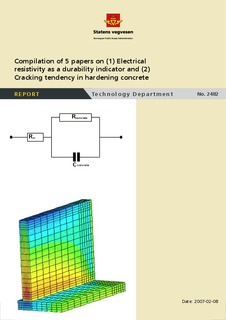| dc.description.abstract | The report contains 5 papers that were presented at the 2nd Int. symposium on Advances in Concrete through Science and Engineering 11-13 Sept. 2006, Quebec City, Canada (printed in the symposium proceedings RILEM PRO 51, ISBN 2-35158-003-06, Ed. by J.Marchand and B.Bissonnette). The first three papers deal with electrical resistivity as a durability parameter for concrete, while the two last papers deal with cracking tendency of hardening concrete. Electrical resistivity (Paper 1-3): The parameter is very important as a durability indicator since high resistivity is beneficial as it means slow corrosion. Electrical resistivity (ER) has been studied with regard to electrical frequency range, concrete degree of saturation (DS), -temperature, -aging effect and -composition. The total investigation include lab. tests on lab.- made specimens and on field cores, as well as field measurements on long term sea exposed concrete elements using both automatic and manual monitoring systems. The ER (lab.and field tests) of water and atmospherically stored high performance concretes (HPC) increased clearly over time (years) due to aging effects, while sea water exposure (field cores) did not display any clear increase. In the latter condition the positive aging effect is believed to be counteracted by the intrusion of chlorides (more ions - lower ER). For water stored HPC even a small decrease in DS clearly increased the ER (indicating early discontinuity of the capillary water), while for traditional bridge concrete with higher w/b the resistivity was not so affected by DS. In the field measurements, over years, on sea exposed elements a beneficial aging effect was seen. The ER increases, not surprisingly, with concrete quality (especially for w/b-ratios below around 0.40); in the field tests this was particularly the case after longer times. Very high ER values were found for the concretes with fly-ash (both lab. and field), especially at longer times.
Cracking tendency in hardening concrete (Paper 4-5): Thermal (TD)- and autogenous (AD) deformations are the primary causes of self-induced stresses in hardening concrete structures subjected to restraint conditions. Much attention has been paid to AD during the last 10-15 years. This is seen, for instance, as the many conferences devoted exclusively to ADaspects. In general, except for super HPC (w/b-ratios below 0.3), it appears that TD is greater than AD and it is therefore surprising that little attention has been paid to the coefficient of thermal expansion (CTE) in recent literature. Paper 4 presents an experimental strategy on how to separate TD and AD in tests and discusses the mechanisms behind the strong moisture dependence of the CTE. Paper 5 shows experimental results from a study on the effect of fly-ash (FA) on crack sensitivity. The given test series shows a beneficial effect of FA when an efficiency factor (k) of 1.0 is used for FA in the effective w/b-ratio calculation. The standards prescribes k=0.4 for FA added during mixing and k=1.0 when FA is part of a certified cement. The paper discusses this issue. | nb_NO |
